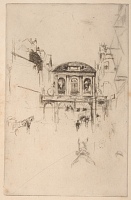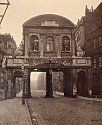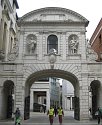Temple Bar | ||
| Number: | 175 | |
| Date: | 1877 | |
| Medium: | etching and drypoint | |
| Size: | 214 x 137 mm | |
| Signed: | no | |
| Inscribed: | no | |
| Set/Publication: | no | |
| No. of States: | 4 | |
| Known impressions: | 5 | |
| Catalogues: | K.162; M.159; W.133 | |
| Impressions taken from this plate (5) | ||
KEYWORD
TITLE
'Temple Bar' (1877, Charles Augustus Howell (1840?-1890)). 3
'Temple Bar' (1878, Whistler). 4
'Temple Bar' (1886, Frederick Wedmore (1844-1921)). 5
3: Howell to Whistler, [6-25 November 1877], GUW #02178.
4: Whistler to A. J. Chapman, 9 August 1878, GUW #07966.
5: Wedmore 1886 A (cat. no. 133).
DESCRIPTION
SITE
6: 'Archaeology and photography', The Times, London, 6 July 1877, p. 4.
In 1878 the City of London Corporation dismantled Temple Bar, numbering and preserving the stones. In 1880, Henry Bruce Meux (1857-1900) bought the stones at the instigation of Valerie Susan Meux (1847-1910) - this was shortly before Lady Meux posed to Whistler for her portrait. The arch was re-erected as a gateway at his house, Theobalds Park, in Hertfordshire.
7: 'Temple Bar', The Times, London, 16 November 1877, p. 9.
8: 'Temple Bar', City of London website, http://www.cityoflondon.gov.uk (accessed 2009).
DISCUSSION
Later views showing it as a decayed but picturesque corner of London included John Wykeham Archer's etching, Old Bulk Shop, Temple Bar, published in Vestiges of Old London by David Bogue in 1851. 10 A friend of Whistler, Percy Thomas (1846-1922), made a topographical etching and drypoint study of Temple Bar, in 1868, which shows the Bar from a similar viewpoint to that used by Whistler. 11 A view of the bar, showing that the gate was a serious obstruction to traffic, appeared in the Illustrated London News in 1870.
In 1877 the 'Society for Photographing Relics of Old London' began publication of a series of photographs. The second set included a photograph of Temple Bar (No. 19), taken from almost exactly the same position as Whistler's etching. This coincided with newspaper reports of the planned demolition of the Bar. Thus Whistler's etching was a record of a famous London landmark that was threatened with demolition. As such it is one of several prints documenting a vanishing London. It is not clear if Whistler was interested in the preservation of ancient buildings or merely saw them as potentially lucrative subjects.
9: British Museum Prints and Drawings, S,2.16; see website at http://www.britishmuseum.org (accessed 2009).
10: British Museum, BM 1851,0614.24.
11: British Museum 1873,0712.960 and 1873,0712.961.
12: British Museum 1939,0620.18; Museum of London id: 142851.
13: Etching, The Hunterian; oil, National Gallery of Canada; Robins 2007, pp. 146-147, figs. 160, 163.



